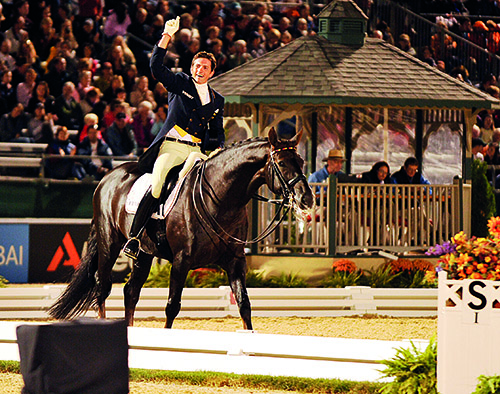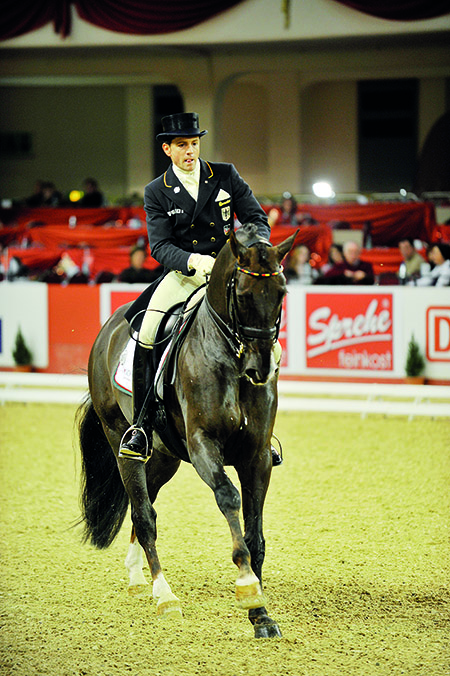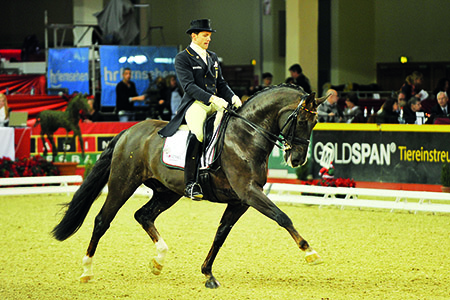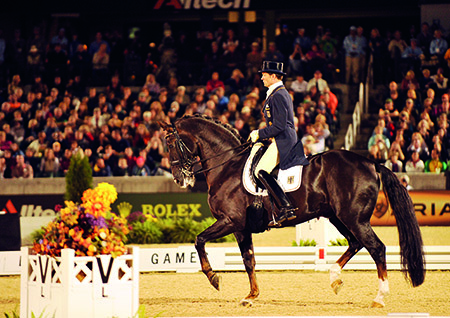Story Chris Hector & Photos Roz Neave
I guess it was time for some new faces at the top of World Dressage, and I am sure the female fans are happy that one of those faces belongs to Christoph Koschel (steady girls, he is happily married with a partner who is very much part of the Koschel training team…) Christoph was something of an outsider coming into the World Equestrian Games in Kentucky, but a series of super performances on his handsome liver verging on black gelding, Donnperignon saw him cementing a place in the team for some time yet.
I caught up with Christoph between rides at the Frankfurt Horse Show, he is not just a very stylish rider, but he is a very thoughtful, and articulate, guy…
Was it inevitable that you were going to become a horse trainer? You studied as a lawyer, but now you are riding and training full-time…
“I was always working with horses, because of my father. I started very young on the junior / young rider tour, but after school I studied law because I wanted to have something else, but I was always riding – in the morning I rode and in the afternoon, I studied.”
“Then my father asked me, what do you want to do in the future? Do you want to continue as a rider and trainer, or do you want to be a lawyer. I decided for the sport, and the horses. Maybe I can be a lawyer later when I am older… That was the time we decided to build our own barn. My father had always rented boxes, and never had his own barn, so after I finished my studies, we decided to set up our own place.”
Is it hard, you deal and sell a lot of horses, is it hard to keep the really good one and become a top competitive rider?
“That’s true, we are professionals, and sometimes you have to sell a top horse because that is our living. We don’t have the background that lets us keep every horse. It’s hard to find a good sponsor in Germany who will say, okay, I will sponsor you to keep that good horse. It is quite hard, on one side you have to make a living, and on the other hand, you like to compete, you have to find a middle way.”
How did you find Donnperignon?
“Donnperignon was offered to us by a friend. My father was the trainer of the Finnish dressage team many years ago, in the 80’s, and we still have a good friend from that time, Jenni Eriksson who lives in Hamburg. She competed at the 1988 Olympic Games and she has good connections to Finland – Donnperignon is by Donnerhall, but on the mother line he is similar to Kyra Kyrklund’s Matador – May Sherif. He was born in Finland and came as a very young horse to Germany to Jenni’s stable. She offered the horse to us when he was just turned four. He had just started being ridden, he was not the biggest mover at that time, but he was fantastic looking. What made him attractive for us was that he was always active and always willing, the sort of horse you need for Grand Prix. A really willing horse and hot – he bucked me off a lot of times. He was a stallion when we got him, but only for one week because he was a bit too crazy. But you could see the talent even when he was a young horse for the collected movements.”
Did you take him to the young horse classes?
“I tried it once. I rode him for Finland at the World Championships for Young Horses in Verden in the six year old championship. He was in the middle of the field because he is not the type of horse you would take to the young horse classes, he was always a horse willing to learn and good for the collected movements, so we prepared him right from the beginning, for Grand Prix sport.”
How early do you introduce the collected work?
“We start to play around with it normally at the beginning of their five year old year. Maybe start with a little in hand work just to test the talent of the horse – when you can see talent and they are willing to do it, then you stop – don’t do it too early. It’s different, some horses have the talent right from the beginning, some horses you can help, maybe they want to do it, but they don’t have the right rhythm and you can help them to find the rhythm. It’s a good age when they are five and six to just start with it, for a good Grand Prix horse, when they are seven they should be quite safe in piaffe and passage.”
What level did you start competing him?
“I competed him in Prix St Georges a few times, just to get him used to the shows. The first time in Grand Prix was right in the beginning of 2009…”
And in 2010 you competed at the WEG – that was quick…
“Yes it was quick, we are lucky here in Germany, we have the Nürnberger Burgpokal – the series for the young Prix St Georges horses, then we have the Meydan Cup series for the eight to ten year old Grand Prix horses, and that is a very nice way to introduce horses to the Grand Prix sport – you don’t have to compete at an international level against the very good horses. For the first year of Grand Prix they can find their own way, and the tests are not so difficult as a normal Grand Prix.”
“He is eleven years old now, and he has been one year competing in international sport, but that is the horse. Still I think he has a lot of potential inside, he hasn’t been to so many competitions and maybe he needs a little more experience. He has a lot of talent and that’s why we made it to Kentucky this year.”
Was that tough, to go to Kentucky with a relatively young horse and compete for your country with all that pressure?
“It was amazing, it was great to do that. What I really liked with our trainers this year, we had two young inexperienced horses in the team, but I think it is the right way to build up the young ones – it is good to show them early enough to the judges. I think it was a good decision to build up new combinations and I was really happy to be part of that. I hope with more experience, then next year we can do it even better. After Kentucky he had a break for two months, I only cantered him. But you can see with a young horse even if you don’t work them on Grand Prix movements every day, even when you let them relax, they still learn. It’s amazing, sometimes you don’t do any exercises but they still learn. They get more condition, they get more powerful. With my horse it is not just a matter of experience, it is a matter of power, and as he matures, then he will get better in the technical movements.”
One thing about your horse is that he always looks comfortable in the Grand Prix test, he never swishes his tail or anything like that… is that an art, to keep a horse happy in the work at Grand Prix level?
“I think so, it is true, he is a really happy horse, and I try at home with every horse to make every day different. Okay sometimes you have to work on the exercises, but we try to go out with the horses and go on the racetrack. We are lucky that we have the woods, and I take them out for rides in the woods. I do the conditioning work on the racetrack, a lot of canter work. When they can do everything and they are safe in the exercises then you have to find a way to keep them happy. With him for example, we had a lot of free time after Kentucky, he is still working every day, long enough to improve his condition – but no exercises at all, I just wanted to keep him happy. He really likes cantering on the racetrack.”
Are you a very theoretical rider, or are you an instinctive rider?
“It depends, but I think more instinctive…”
Do you use draw reins?
“Normally not in the daily work. I think draw reins are always a difficult issue, but I think sometimes they can help you, especially with young horses, just to show them the way, if you have a bit of a wild horse they help to keep them under control, but I really try to work my horses in a snaffle – just the week before the competition, I start with the double. My horses know it, when the double comes, they know competition is coming and they really change, you can feel them looking forward to the competition.”
Do you still work him from the ground, in hand?
“No not with him. It depends on the horse, if you have a horse that is very slow and big in the piaffe / passage for example, you can make them quicker from the ground. You can show them they have to be quicker and the transitions are easier. Some horses let you help them from the ground, but some horses you can’t even touch them with the long whip, then it is better to do it on top. It really depends on the horse, you have to have a feeling for it to find the best way for the horse.”
What was the hardest thing to teach with Donnperignon?
“It’s hard to say. The collected work is really easy for him, and most of the exercises in the Grand Prix are out of collection, piaffe and passage were easy, the canter work is normally easy, it was more to improve the gaits. He was not the biggest trotter when he was young. He learned the trot really over the passage, to get it forward. Now I think he’s got a fantastic extended trot but as I said, he was not the typical horse for the young horse classes because there you see the very big movers, but the classical Grand Prix horse – when you look at the first 20 in the world – many of them were not the biggest trotters in the beginning, more the horses you make with the collected work. He’s the same, the challenge was more to get the movement bigger, the exercises he learned very quickly.”
Will you still have the ride on him for the London Games?
“He is our own horse so we can decide what to do, and our decision is to keep him. Okay German dressage is always very strong, I was very happy last year to be on the team for Kentucky, but every year you have to compete very well, because it is getting harder again in Germany. With Totilas, we have a new horse, and Isabell always has a good horse in the background, Ulla Salzgeber is coming again, so we have many combinations and you have to compete on a very high level to be on the team.”
This story originally appeared in the March 2011 edition of The Horse Magazine




